1.2 Cornus Florida
Nataliya Burges
Cornus Florida
Author: Nataliya Burges
1. Plant Description
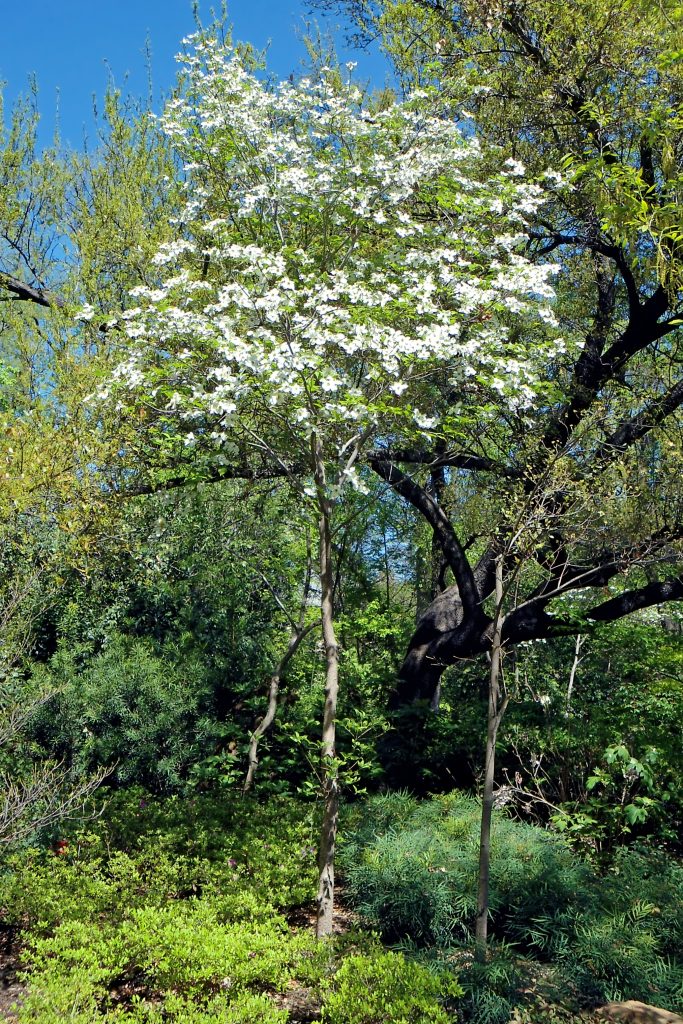
Cornus, commonly known as Dogwood, is a varied group of deciduous trees, shrubs, and herbs in the dogwood family (Cornaceae), native to Europe, eastern Asia, and North America (Dogwood, 2022). The dogwood family consists of 15 species in North America and 10 species native to Canada, two of which are herbaceous (Arseneault, 2015). Most dogwoods are shrubs or small trees; however, Pacific (mountain) or western flowering dogwood (C. nuttallii), can grow up to 25 m. The smallest and most known species is the Canadian bunchberry (C. canadensis), which is found in southwestern Ontario in the Carolinian forest region – a unique area with a very specific ecosystem(Beaulieu, 2022; Government of Ontario, 2022). Bunchberry ground cover is low-growing, deciduous, shrubby with leaves and flowers, and similar to the Flowering dogwood tree but smaller (20 cm)(Beaulieu, 2022). Flowering Dogwood (Cornus florida) is native to mixed forests in Canada and the northern US to eastern Mexico(Beaulieu, 2022). The genus Cornus comes from the Latin word cornu, which means hard and refers to the wood of the tree, while florida comes from the Latin word flos which means “flowery” or “in bloom”(North Carolina Plant Toolbox, n.d.). Flowering Dogwood is perhaps the most popular tree of eastern growing but is becoming increasingly rare in the Carolinian zone of southwestern Ontario due to anthracnose disease(Government of Ontario, 2022). To prevent wildlife species in Canada from disappearing, the Nature Conservancy of Canada (NCC) conserved 1,740 hectares of land, including the Carolinian forest. Species at risk and some of the oldest trees in Ontario were protected.
2. Identification
Flowering Dogwood is a woody, deciduous, flowering understory tree that may grow 4.5 m to 7.5 m tall and 10 to 15 cm in diameter. The trees bloom for a few weeks in the spring, with four large white flower-like bracts before the leaves expand(University of Kentucky, n.d.). In late summer, the tree has bright red berries that are often eaten by birds. Its leaves turn a scarlet red in the fall before dropping(University of Kentucky, n.d.).
Flowering Dogwood is usually found on the edges of the forest; it likes light, moderate, and partial shade to protect it from sunburn(Al, n.d.). If they get full shade, like back deep in the forest, the trees don’t flower at all(Al, n.d.). The best place for gardeners to plant their dogwood trees is a location with morning sun and afternoon shade.
Anatomically, The Dogwood flower is a compound of greenish-yellow flowers in the centre, surrounded by modified leaf tissue – creamy bracts which help to attract pollinators (University of Kentucky, n.d.). When every individual flower gets pollinated, it will develop into a red fruit with a hard seed inside.
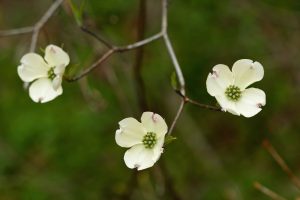
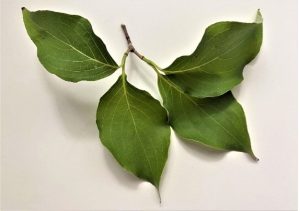
The leaves make a good identifying feature. They are oval and oppositely arranged on the twig, right across from each other, with very prominent venation: on the midrib, there are strong mid roots down the center, where all the veins curve up towards the top of the leaf. Fall leaf colour can be displayed from orange to red to purple. On the older trees, the bark gets very cobblestone-textured (Bernheim, n.d.).
The fruit of the flowering dogwood tree is an important wildlife food – as an attractive red droop, it will be in clusters of usually 3 to 5 shiny bright red berries. Dogwood trees may not produce fruit for the first 10 years. The trees must reach maturity and can flower. This can take up to 6 years in C. florida(McLemore, n.d.). If trees were not grown from seeds, they could produce flowers and berries a lot more quickly (Al, n.d.). Flowering Dogwood fruits are harmful to humans and not to animals, and especially enjoyed by birds from fall through winter (Iupilon, 2021; Missouri Botanical Garden, n.d.).
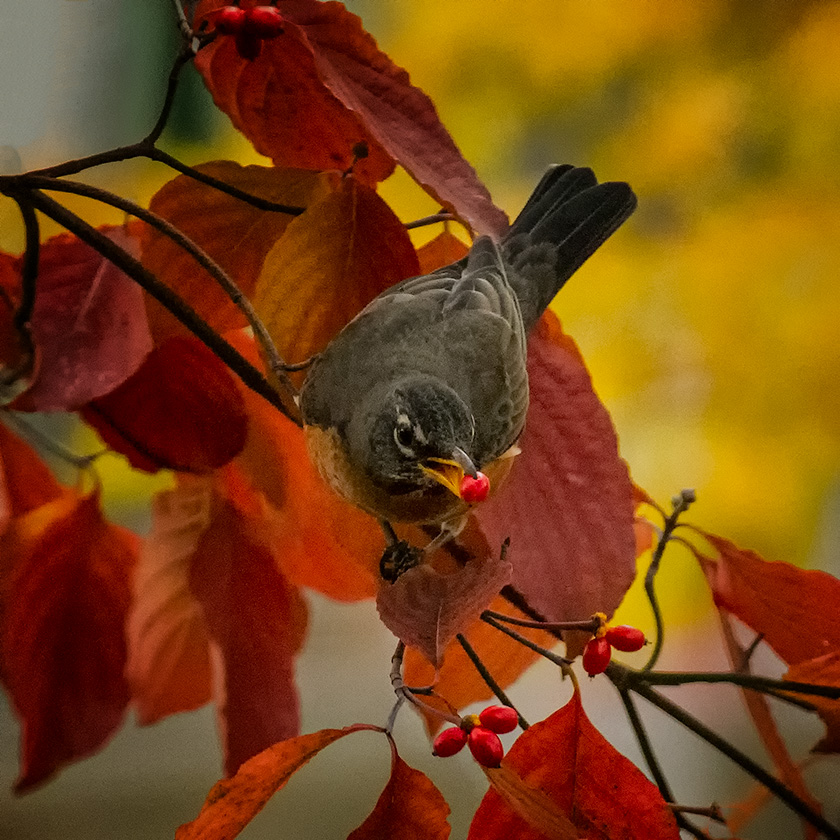
3. Cultivation
Flowering dogwood prefers well-drained, slightly acidic (optimum pH 5.5 to 6.0) and nutrient-rich soils of lower and mid slopes (Myers, 2023). During the first year of growth, young dogwoods do not need regular fertilizing (Leonard, 2022). Compost would be an excellent choice for boosting the soil with little to no risk of overloading the trees with excess nutrients (Leonard, 2022). Since dogwood roots are shallow, soil moisture should be maintained during a very dry season or drought, avoiding oversaturation (Al, n.d.). In a location that is overly wet or with soil that floods, the trees will not tolerate waterlogging (Al, n.d.).
Dogwoods are not only a favourite ornamental tree of homeowners, but they are also important to wildlife. Many species of caterpillars feed on their leaves; more than 50 species of birds feed on berries of flowering dogwood in the Backus Woods of Ontario alone. Underneath flowering dogwood is the highest snail diversity in the entire forest (McGlone, n.d.). Since dogwood is good at sequestering calcium out of soil and when the leaves fall, it deposits calcium onto the surface (Government of Ontario, 2021). Snails can eat that and use calcium for their shells. Flowering Dogwood is considered a soil improver and a leaf litter that is an important source of calcium (Government of Ontario, 2021; McLemore, n.d.).
4. Cultural History
The Dogwood fruit is a great source of vitamin C and has often been used in traditional medicine(Masons, n.d.). Native Americans used dogwood for a variety of illnesses. It is rumoured they first started using plants and herbs for healing after watching animals eat certain plants when they were sick. Indigenous people used C. florida to treat colic and fevers, and a medicinal infusion could be made from the bark, flowers, and fruit (United States Department of Agriculture, 2004). Some tribes revered the dogwood tree as a symbol of good luck and masculinity, eating Dogwood berries during religious ceremonies. Dogwood sap is toxic and was used by Native Americans as poison (Native Languages of the Americas, n.d.).
5. Life Cycle
Eastern Flowering Dogwood is a moderately fast-growing tree that lives up to approximately 80 years (Balogh, 2023; Government of Ontario, 2023). Plant flowering dogwood can grow easily from seed in nature. Clean seed that has been cold stratified for over 90 days germinates near 100 percent in the spring or occasionally during the second spring after seeds fall. Seed production begins as early as 6 years of tree maturity and generates a good seed crop every other year (bplant.org, n.d.; McLemore, n.d.). Fruits are shiny, oval red drupes, 13 mm long and in clusters of 3 to 5 berries. Ripened from September to October, Flowering Dogwood seeds are distributed by birds and small animals throughout forests.
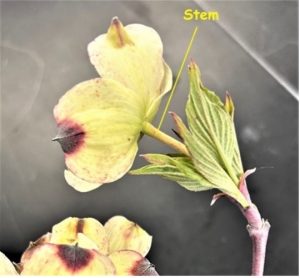
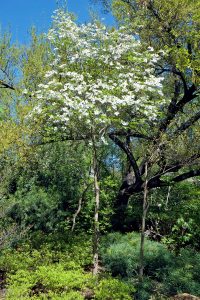
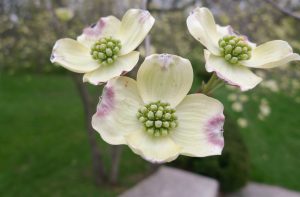
6. Anatomy and Physiology
Dogwood’s flowers emerge before the leaves in early spring. Its true flowers are visited by butterflies and specialized bees. The “flowers” of the flowering dogwood are one of the most confounding features of dogwood. What people perceive to be the flower is a false flower, and the four large “petals” are involucral bracts (modified leaves) that have the appearance of flower petals (Missouri Botanical Gardens, n.d.). The actual flowers are a cluster of small flowers in the center of the four bracts.
The Flowering Dogwood trees are dicots – the most complex vascular plants. Within the Dogwood’s stem, there are three types of tissues: dermal tissues, ground tissues and vascular tissues. The cross-section through the stem (Figure 1.2.10) displays the outer layer of the epidermis, which is the dermal tissue. The epidermis consists of the outer cuticle layer with epidermal hairs that protect the stem. The ground tissue within the stem is divided into the cortex and the pith. The vascular tissues are made up of a ring of vascular bundles. The vascular cambium separates the phloem and xylem: the phloem is exterior to the xylem.
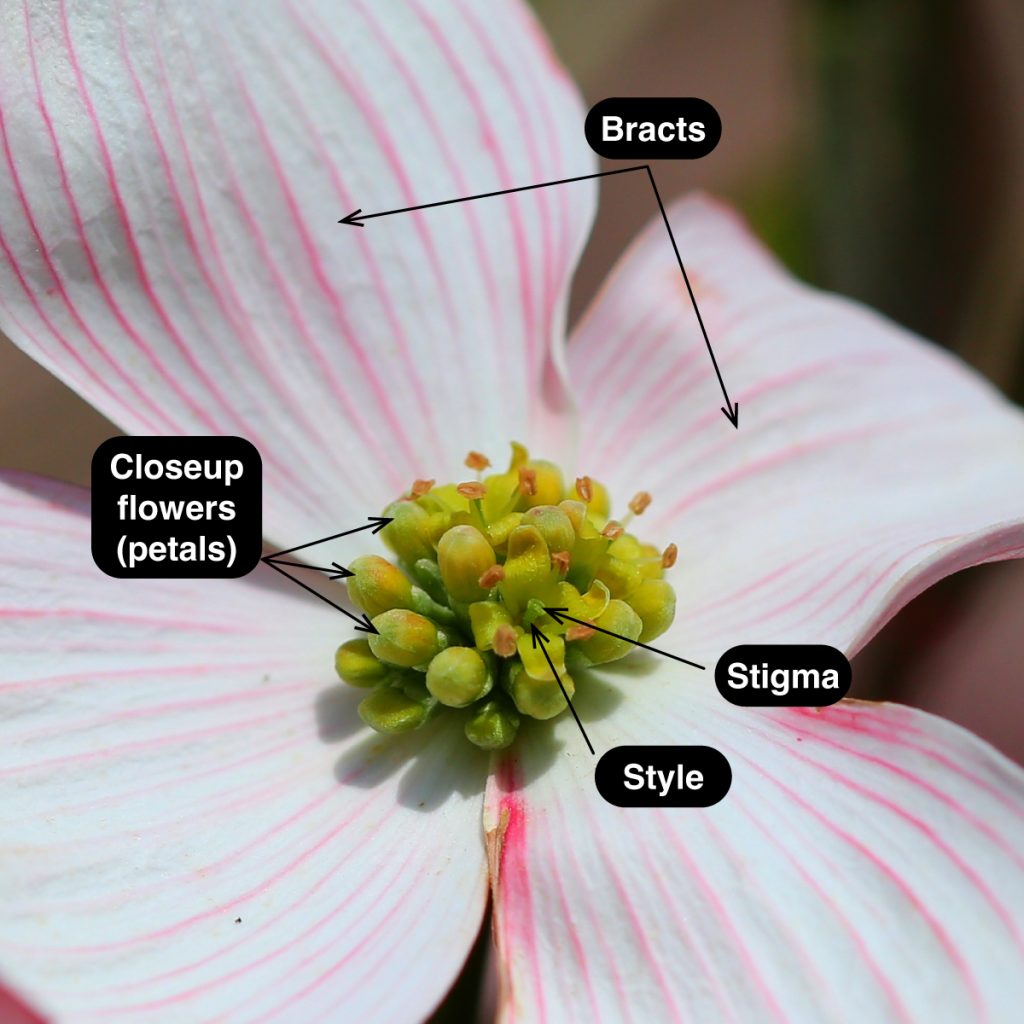
The xylem is involved in the transport of water from the roots to the stems, while the phloem is involved in the movement of food substances made in the leaves down to all other parts of the plant (Kimball, 2023). The pith is made up of loosely packed parenchyma tissues, whose function is storing nutrients.

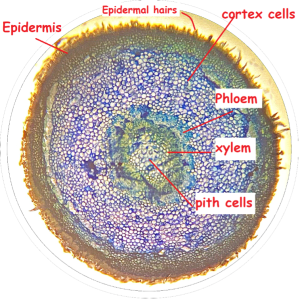
As the tree grows from a small sapling into a big plant, the leaf size remains almost the same. With the increase of lateral growth of the tree, the leaf size does not increase. The reason is that mature leaves contain permanent tissues, with a lost ability to divide and grow any further. Meristematic tissues, which are diving cells, convert to form parenchyma tissues. The thin walls of parenchyma tissues in the leaf cells make leaves very flexible and can be folded. Parenchyma contains chloroplast and performs photosynthesis to help the plant manufacture its own food (Kimball, 2023). Parenchyma tissue contains a single large vacuole that occupies maximum space and accumulates all the food molecules in it. With additional depositions on the parenchyma cell walls, the tissues get converted to collenchyma tissues, covering the parenchyma cells from the outside(Kimball, 2023). Collenchyma cells have very thickened cell walls, and the thickness is mostly towards the corners. The presence of all the cellular organelles indicates that collenchyma cells are living cells and perform different functions. They provide mechanical support to the plant by giving rigidity to plant organs (Kimball, 2023).
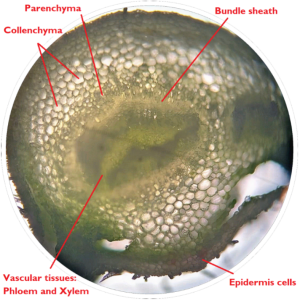
In the summer, leaves are medium to dark green and a deep red colour in the full (Balogh, 2023). While the fruits develop during the summer, the tree grows new flower buds for next spring to bloom. If someone does not already have Flowering Dogwood and lives in its native range, they might consider this small-scale tree next time they are planning to plant a tree. This plant is an excellent choice for the residential landscape. It is extremely beautiful in any season.
References
Al. (2022). Dogwood tree has few or no berries? A straightforward guide. Hands-On Gardening. https://handsongardening.com/dogwood-tree-has-no-berries/
Arseneault, C. (2015, March 4). Dogwood. In The Canadian Encyclopedia. https://www.thecanadianencyclopedia.ca/en/article/dogwood
Balogh, A. (2023). Flowering dogwood trees & shrubs. Garden Design. https://www.gardendesign.com/trees/dogwood.html
Beaulieu, D. (2022, May 31). Bunchberry shade ground cover for native plant landscaping. The Spruce. https://www.thespruce.com/bunchberry-shade-ground-cover-2132948
Bernheim Arboretum and Research Forest. (n.d.). Flowering dogwood. https://bernheim.org/learn/trees-plants/bernheim-select-urban-trees/flowering-dogwood/
bplant.org. (n.d.). Flowering dogwood (Cornus florida). https://bplant.org/plant/110
Dogwood. (2022, May 30). In The Editors of Encyclopaedia Britannica, Encyclopaedia Britannica. https://www.britannica.com/plant/dogwood
Flowering Dogwood (Cornus florida). (n.d.). Texas Parks & Wildlife. https://tpwd.texas.gov/huntwild/wild/species/dgwd/
Government of Ontario. (2021, June 17). Eastern flowering dogwood recovery strategy. https://www.ontario.ca/page/eastern-flowering-dogwood-recovery-strategy
Government of Ontario. (2022, February 24). Eastern flowering dogwood (Species at risk). https://www.ontario.ca/page/eastern-flowering-dogwood
Government of Ontario. (2023, November 22). Eastern flowering dogwood. https://www.ontario.ca/page/eastern-flowering-dogwood-species-risk
Iupilon. (2021, October 26). Which dogwood berries are edible. https://iupilon.com/which-dogwood-berries-are-edible/
Kimball, J. W. (2023, November 1). Biology. LibreTexts. https://bio.libretexts.org/Bookshelves/Introductory_and_General_Biology/Biology_(Kimball)/03%3A_The_Cellular_Basis_of_Life/3.19%3A_Plant_Tissues
Leonard, C. (2022, September 18). How to plant and care for a dogwood tree. Happy Sprout. https://www.happysprout.com/gardening/plant-dogwood-tree/
Masons, F. (n.d.). Dogwood tree information. The Tree Center Plant Supply Co. https://www.thetreecenter.com/dogwood-tree-information/
McGlone, J. (n.d.). Dogwoods: Can Eastern forests function without them? Fairfax County Virginia. https://www.fairfaxcounty.gov/soil-water-conservation/dogwoods-can-eastern-forests-function-without
McLemore, B. F. (n.d.). Flowering dogwood. U.S. Forest Service. https://www.srs.fs.usda.gov/pubs/misc/ag_654/volume_2/cornus/florida.htm
Missouri Botanical Garden. (n.d.). Cornus florida. https://www.missouribotanicalgarden.org/PlantFinder/PlantFinderDetails.aspx?kempercode=c280
Myers, V. R. (2023, February 21). 12 types of dogwood trees and shrubs. The Spruce. https://www.thespruce.com/twelve-species-dogwood-trees-shrubs-subshrubs-3269662
Native Languages of the Americas. (n.d.). Native American dogwood mythology. https://www.native-languages.org/legends-dogwood.htm
North Carolina Plant Toolbox. (n.d.). Cornus florida. https://plants.ces.ncsu.edu/plants/cornus-florida/
United States Department of Agriculture. (2004). Flowering dogwood. https://plants.usda.gov/DocumentLibrary/plantguide/pdf/pg_cofl2.pdf
University of Kentucky: College of Agriculture, Food and Environment. (n.d.). Flowering dogwood. https://www.uky.edu/hort/Flowering-Dogwood
USA National Phenology Network. (n.d.). Flowering dogwoods. Nature’s Notebook. https://www.usanpn.org/nn/dogwoods
Western flowering dogwood. (n.d.). Government of British Columbia. https://www2.gov.bc.ca/gov/content/industry/forestry/managing-our-forest-resources/silviculture/tree-species-selection/tree-species-compendium-index/western-flowering-dogwood


